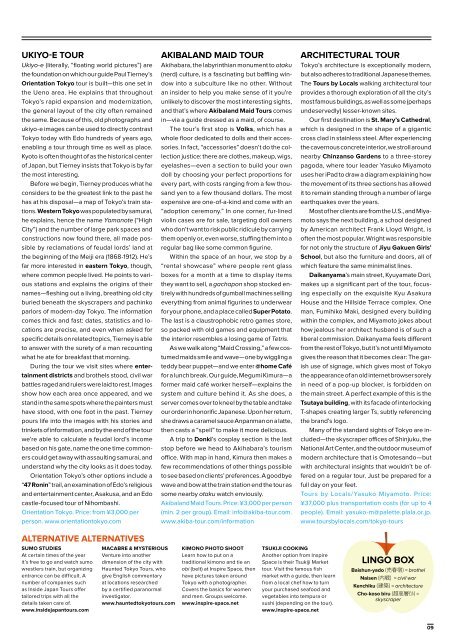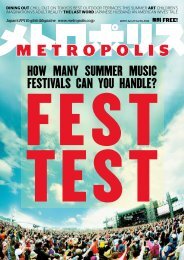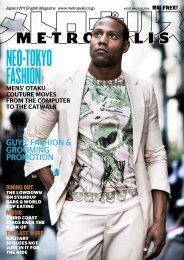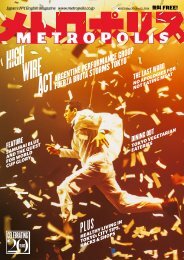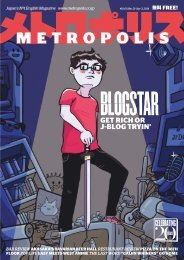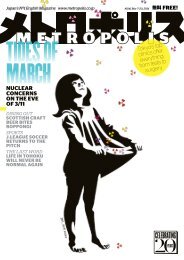Metropolis-Aug-8-2014
Metropolis-Aug-8-2014
Metropolis-Aug-8-2014
Create successful ePaper yourself
Turn your PDF publications into a flip-book with our unique Google optimized e-Paper software.
UKIYO-E TOUR<br />
Ukiyo-e (literally, “floating world pictures”) are<br />
the foundation on which our guide Paul Tierney’s<br />
Orientation Tokyo tour is built—this one set in<br />
the Ueno area. He explains that throughout<br />
Tokyo’s rapid expansion and modernization,<br />
the general layout of the city often remained<br />
the same. Because of this, old photographs and<br />
ukiyo-e images can be used to directly contrast<br />
Tokyo today with Edo hundreds of years ago,<br />
enabling a tour through time as well as place.<br />
Kyoto is often thought of as the historical center<br />
of Japan, but Tierney insists that Tokyo is by far<br />
the most interesting.<br />
Before we begin, Tierney produces what he<br />
considers to be the greatest link to the past he<br />
has at his disposal—a map of Tokyo’s train stations.<br />
Western Tokyo was populated by samurai,<br />
he explains, hence the name Yamanote (“High<br />
City”) and the number of large park spaces and<br />
constructions now found there, all made possible<br />
by reclamations of feudal lords’ land at<br />
the beginning of the Meiji era (1868-1912). He’s<br />
far more interested in eastern Tokyo, though,<br />
where common people lived. He points to various<br />
stations and explains the origins of their<br />
names—fleshing out a living, breathing old city<br />
buried beneath the skyscrapers and pachinko<br />
parlors of modern-day Tokyo. The information<br />
comes thick and fast: dates, statistics and locations<br />
are precise, and even when asked for<br />
specific details on related topics, Tierney is able<br />
to answer with the surety of a man recounting<br />
what he ate for breakfast that morning.<br />
During the tour we visit sites where entertainment<br />
districts and brothels stood, civil war<br />
battles raged and rulers were laid to rest. Images<br />
show how each area once appeared, and we<br />
stand in the same spots where the painters must<br />
have stood, with one foot in the past. Tierney<br />
pours life into the images with his stories and<br />
trinkets of information, and by the end of the tour<br />
we’re able to calculate a feudal lord’s income<br />
based on his gate, name the one time commoners<br />
could get away with assaulting samurai, and<br />
understand why the city looks as it does today.<br />
Orientation Tokyo’s other options include a<br />
“47 Ronin” trail, an examination of Edo’s religious<br />
and entertainment center, Asakusa, and an Edo<br />
castle-focused tour of Nihombashi.<br />
Orientation Tokyo. Price: from ¥3,000 per<br />
person. www.orientationtokyo.com<br />
AKIBALAND MAID TOUR<br />
Akihabara, the labyrinthian monument to otaku<br />
(nerd) culture, is a fascinating but baffling window<br />
into a subculture like no other. Without<br />
an insider to help you make sense of it you’re<br />
unlikely to discover the most interesting sights,<br />
and that’s where Akibaland Maid Tours comes<br />
in—via a guide dressed as a maid, of course.<br />
The tour’s first stop is Volks, which has a<br />
whole floor dedicated to dolls and their accessories.<br />
In fact, “accessories” doesn’t do the collection<br />
justice: there are clothes, makeup, wigs,<br />
eyelashes—even a section to build your own<br />
doll by choosing your perfect proportions for<br />
every part, with costs ranging from a few thousand<br />
yen to a few thousand dollars. The most<br />
expensive are one-of-a-kind and come with an<br />
“adoption ceremony.” In one corner, fur-lined<br />
violin cases are for sale, targeting doll owners<br />
who don’t want to risk public ridicule by carrying<br />
them openly or, even worse, stuffing them into a<br />
regular bag like some common figurine.<br />
Within the space of an hour, we stop by a<br />
“rental showcase” where people rent glass<br />
boxes for a month at a time to display items<br />
they want to sell, a gachapon shop stocked entirely<br />
with hundreds of gumball machines selling<br />
everything from animal figurines to underwear<br />
for your phone, and a place called Super Potato.<br />
The last is a claustrophobic retro games store,<br />
so packed with old games and equipment that<br />
the interior resembles a losing game of Tetris.<br />
As we walk along “Maid Crossing,” a few costumed<br />
maids smile and wave—one by wiggling a<br />
teddy bear puppet—and we enter @home Café<br />
for a lunch break. Our guide, Megumi Kimura—a<br />
former maid café worker herself—explains the<br />
system and culture behind it. As she does, a<br />
server comes over to kneel by the table and take<br />
our order in honorific Japanese. Upon her return,<br />
she draws a caramel sauce Anpanman on a latte,<br />
then casts a “spell” to make it more delicious.<br />
A trip to Donki’s cosplay section is the last<br />
stop before we head to Akihabara’s tourism<br />
office. With map in hand, Kimura then makes a<br />
few recommendations of other things possible<br />
to see based on clients’ preferences. A goodbye<br />
wave and bow at the train station end the tour as<br />
some nearby otaku watch enviously.<br />
Akibaland Maid Tours. Price: ¥3,000 per person<br />
(min. 2 per group). Email: info@akiba-tour.com.<br />
www.akiba-tour.com/information<br />
ARCHITECTURAL TOUR<br />
Tokyo’s architecture is exceptionally modern,<br />
but also adheres to traditional Japanese themes.<br />
The Tours by Locals walking architectural tour<br />
provides a thorough exploration of all the city’s<br />
most famous buildings, as well as some (perhaps<br />
undeservedly) lesser-known sites.<br />
Our first destination is St. Mary’s Cathedral,<br />
which is designed in the shape of a gigantic<br />
cross clad in stainless steel. After experiencing<br />
the cavernous concrete interior, we stroll around<br />
nearby Chinzanso Gardens to a three-storey<br />
pagoda, where tour leader Yasuko Miyamoto<br />
uses her iPad to draw a diagram explaining how<br />
the movement of its three sections has allowed<br />
it to remain standing through a number of large<br />
earthquakes over the years.<br />
Most of her clients are from the U.S., and Miyamoto<br />
says the next building, a school designed<br />
by American architect Frank Lloyd Wright, is<br />
often the most popular. Wright was responsible<br />
for not only the structure of Jiyu Gakuen Girls’<br />
School, but also the furniture and doors, all of<br />
which feature the same minimalist lines.<br />
Daikanyama’s main street, Kyuyamate Dori,<br />
makes up a significant part of the tour, focusing<br />
especially on the exquisite Kyu Asakura<br />
House and the Hillside Terrace complex. One<br />
man, Fumihiko Maki, designed every building<br />
within the complex, and Miyamoto jokes about<br />
how jealous her architect husband is of such a<br />
liberal commission. Daikanyama feels different<br />
from the rest of Tokyo, but it’s not until Miyamoto<br />
gives the reason that it becomes clear: The garish<br />
use of signage, which gives most of Tokyo<br />
the appearance of an old internet browser sorely<br />
in need of a pop-up blocker, is forbidden on<br />
the main street. A perfect example of this is the<br />
Tsutaya building, with its facade of interlocking<br />
T-shapes creating larger Ts, subtly referencing<br />
the brand’s logo.<br />
Many of the standard sights of Tokyo are included—the<br />
skyscraper offices of Shinjuku, the<br />
National Art Center, and the outdoor museum of<br />
modern architecture that is Omotesando—but<br />
with architectural insights that wouldn’t be offered<br />
on a regular tour. Just be prepared for a<br />
full day on your feet.<br />
Tours by Locals/Yasuko Miyamoto. Price:<br />
¥37,000 plus transportation costs (for up to 4<br />
people). Email: yasuko-m@palette.plala.or.jp.<br />
www.toursbylocals.com/tokyo-tours<br />
ALTERNATIVE ALTERNATIVES<br />
SUMO STUDIES<br />
At certain times of the year<br />
it’s free to go and watch sumo<br />
wrestlers train, but organizing<br />
entrance can be difficult. A<br />
number of companies such<br />
as Inside Japan Tours offer<br />
tailored trips with all the<br />
details taken care of.<br />
www.insidejapantours.com<br />
MACABRE & MYSTERIOUS<br />
Venture into another<br />
dimension of the city with<br />
Haunted Tokyo Tours, who<br />
give English commentary<br />
at locations researched<br />
by a certified paranormal<br />
investigator.<br />
www.hauntedtokyotours.com<br />
KIMONO PHOTO SHOOT<br />
Learn how to put on a<br />
traditional kimono and tie an<br />
obi (belt) at Inspire Space, then<br />
have pictures taken around<br />
Tokyo with a photographer.<br />
Covers the basics for women<br />
and men. Groups welcome.<br />
www.inspire-space.net<br />
TSUKIJI COOKING<br />
Another option from Inspire<br />
Space is their Tsukiji Market<br />
tour. Visit the famous fish<br />
market with a guide, then learn<br />
from a local chef how to turn<br />
your purchased seafood and<br />
vegetables into tempura or<br />
sushi (depending on the tour).<br />
www.inspire-space.net<br />
LINGO BOX<br />
Baishun-yado ( 売 春 宿 ) = brothel<br />
Naisen ( 内 戦 ) = civil war<br />
Kenchiku ( 建 築 ) = architecture<br />
Cho-koso biru ( 超 高 層 ビル) =<br />
skyscraper<br />
09


